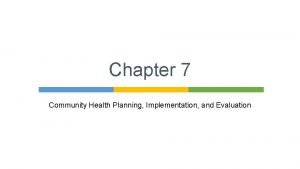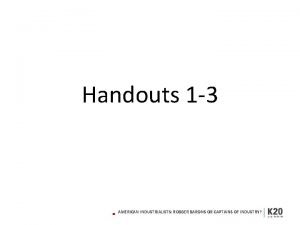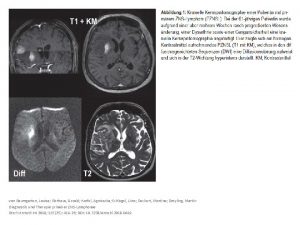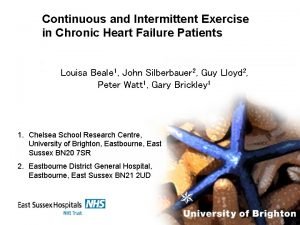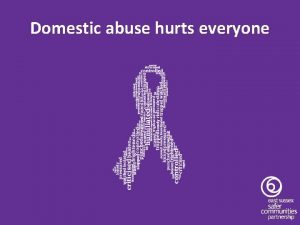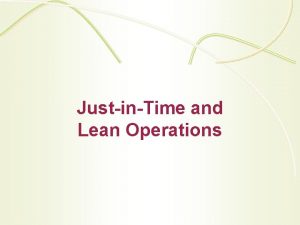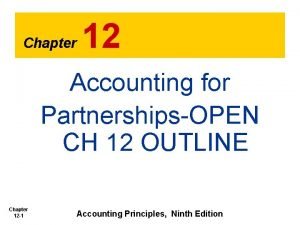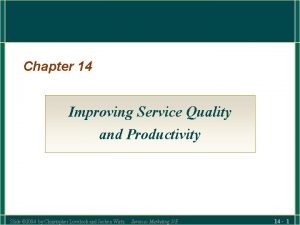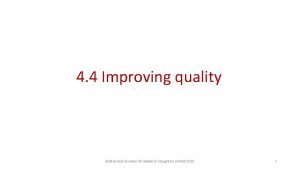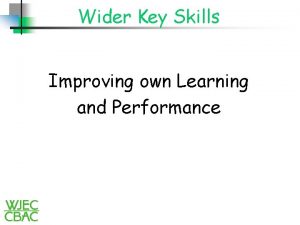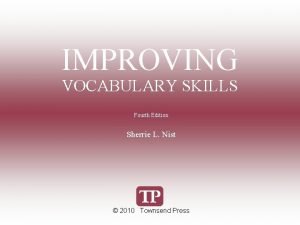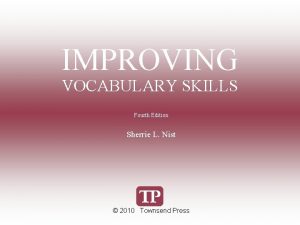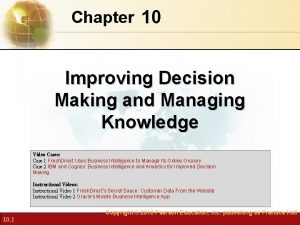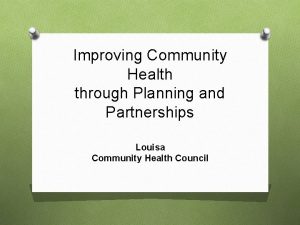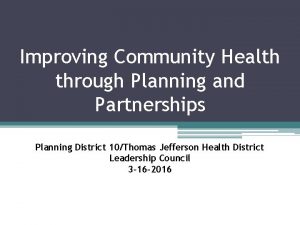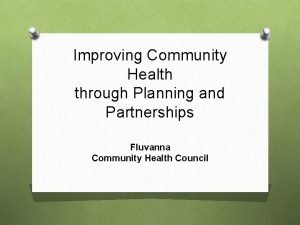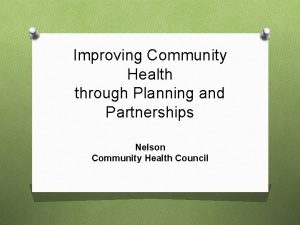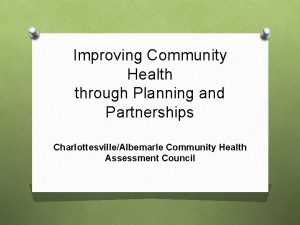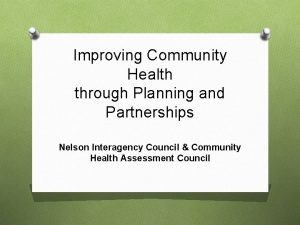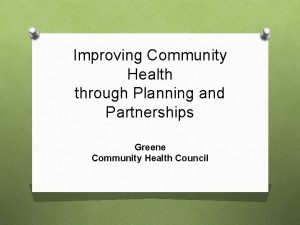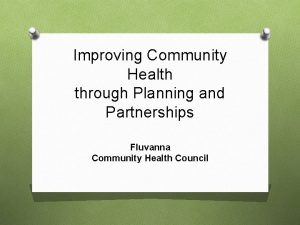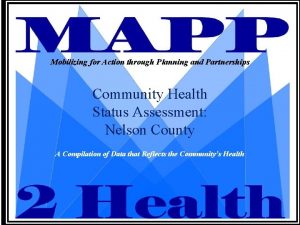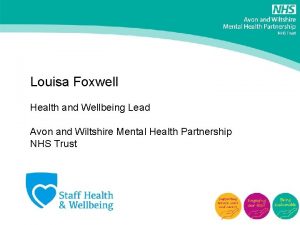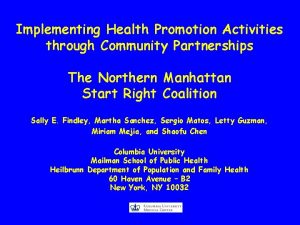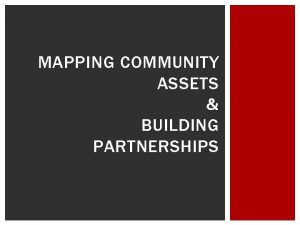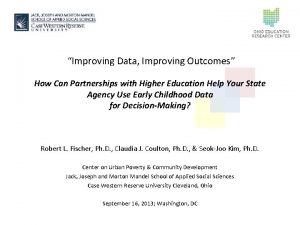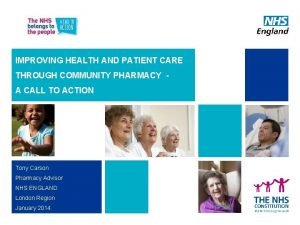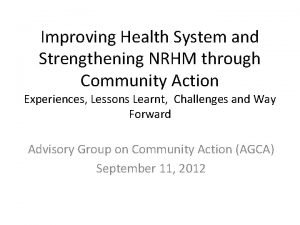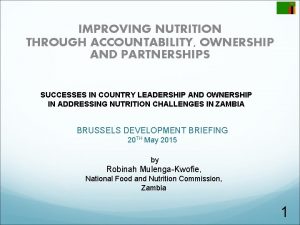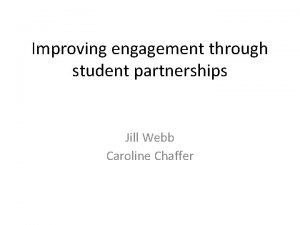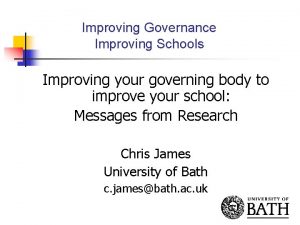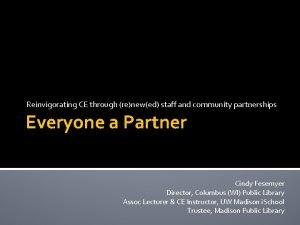Improving Community Health through Planning and Partnerships Louisa



































- Slides: 35

Improving Community Health through Planning and Partnerships Louisa Community Health Assessment Council

Today’s Agenda • Review priorities and goals selected at Leadership Council Meeting on 10/19/16 • Select strategies to address the priorities in Louisa County

Community Health Priorities O Selected at 10/19/16 MAPP Leadership Council meeting O #1: Mental Health & Substance Use O #2: Age and Family-Friendly Continuum O #3: Health Disparities / Access to Care O #4: Obesity and Lack of Recreation O Drafted goals for each community health priority as well

Community Health Priority #1: Mental Health & Substance Use GOAL: Increase culturally and linguistically appropriate capacity and increase community awareness of mental health and substance abuse problems.

Tobacco-Free Community Coalition O Priority from previous MAPP assessment: O Store Alert Program O O evaluated tobacco ads A Task Force increased excise cigarette tax in Cville Quit Smoking classes in Charlottesville and Louisa Great American Smokeout events in Louisa and Charlottesville Grant to reduce % of pregnant women smoking and % of children exposed to secondhand smoke

Community Mental Health and Wellness Coalition (CMHWC) O Strategies from previous round of MAPP: O Establish a system to collect and track the number of CMHWC agencies’ service hours. O Promote the integration of behavioral health services into primary care settings. O Develop, conduct, and promote culturallycompetent educational programs, such as Mental Health First Aid USA, to reduce stigma and fears that prevent individuals from seeking mental health services.

CMHWC Recommended Strategies Addressing Mental Health O Develop public awareness campaigns: O to help residents and providers learn more about available resources O Reduce stigma related to mental health and substance abuse problems O Expand Mental Health First Aid training to reach workplaces, faith based, other groups O Expand screening and early intervention for mental health and substance abuse concerns O Increase service system capacity to address waitlist, cost and other barriers to care Source: Community Mental Health and Wellness Coalition Advocacy Brief (draft), 2016.

CMHWC Recommended Strategies Addressing Barriers to Care O Advocate for policy initiatives to expand O O healthcare access, including parity for insurance payments for behavioral health services Work with local health systems and non-profit and private medical providers to strengthen and expand integrated care Increase tele-health opportunities to reach isolated communities Assess transportation challenges that affect access and develop strategies to address Expand peer and family support for behavioral health services Source: Community Mental Health and Wellness Coalition Advocacy Brief (draft), 2016.

CMHWC Recommended Strategies Addressing Opioid Overdoses O Expand medication assisted treatment and other substance abuse treatment O Work with local healthcare systems to develop effective prescription monitoring and provider education O Promote community awareness and change social norms to recognize the danger of prescription drug misuse and the importance of safe storage and safe disposal O Expand opportunities for prescription drug take back Source: Community Mental Health and Wellness Coalition Advocacy Brief (draft), 2016.

Other Recommended MH/SA Strategies O Expand access to and use of community-based programs for treatment of mental health disorders. O In primary care and other settings, increase use of the Screening, Brief Intervention, Referral and Treatment tool (an evidence-based practice used to identify, reduce, and prevent problematic use, abuse, and dependence on alcohol and illicit drugs). O Establish smoke-free policies and social norms. O Increase the number of providers who screen for nicotine use, including smokeless tobacco and ecigarettes, and provide or refer for cessation services. Source: Virginia Department of Health, Virginia’s Plan for Wellbeing, 2016.

Community Health Priority#2: Age and Family-Friendly Continuum GOAL: Increase wellbeing across the age continuum by supporting education, awareness, and prevention that will lead to a healthy, connected community.

Existing Initiatives/Coalitions O NEW Community Health Priority O Youth Development Council of Greene County O Addresses comprehensive youth development programming (everyday after-school and summer program which provides opportunities and programs to enhance the academic, social, personal and spiritual development of the children and youth who attend) O Charlottesville/Albemarle Coalition on Healthy Youth (CACHY) O a collaborative group of community members and agencies who care for and about young people. O Charlottesville Area Alliance O Vision for greater Charlottesville area to be the most age-friendly community in the country.

Family Planning • Increase access to quality family planning services for all women of child-bearing age. • Educate women and men about the effectiveness of contraceptive methods and increase access to the most effective methods. • Expand evidence-based programs that promote healthy relationships. Source: Virginia Department of Health, Virginia’s Plan for Wellbeing, 2016.

Early Childhood • Increase enrollment of three to five year-old children in early childhood education programs. • From previous meetings: Increase accessible, convenient, affordable, high quality childcare and after school programs. • Increase the number of providers and educators who screen for adverse childhood events (ACEs) and are trained in using a trauma-informed approach to care. • Expand programs that help families affected by ACEs, toxic stress, domestic violence, mental illness, and substance abuse create safe, stable, and nurturing environments. Source: Virginia Department of Health, Virginia’s Plan for Wellbeing, 2016.

Families Maintain Economic Stability • Provide alternative pathways to graduation and post-secondary training for disconnected youth and those with special needs. • Expand training and work-linked learning opportunities for youth. • Support opportunities for mid-career retraining. • Build affordable housing, and rehabilitate existing affordable housing to accommodate low-income families. Source: Virginia Department of Health, Virginia’s Plan for Wellbeing, 2016.

Life-Long Wellness • Encourage construction of safe, congregate and retirement housing for the aging population. • Increase the number of fitness and physical therapy facilities that promote senior fitness • Develop a senior falls prevention program Source: Virginia Department of Health, Virginia’s Plan for Wellbeing, 2016.

Strategies for an Age-Friendly Community O Outdoor spaces and buildings O O Transportation O O Ex: Public transportation is reliable and frequent, including at night and on weekends and holidays. Housing O O Ex: Pavements are non-slip, are wide enough for wheelchairs and have dropped curbs to road level. Ex: Sufficient and affordable housing for frail and disabled older people, with appropriate services, is provided locally. Social participation O Ex: There is consistent outreach to include people at risk of social isolation. O Respect and social inclusion O Ex: Schools provide opportunities to learn about aging and older people, and involve older people in school activities. O Civic participation and employment O Ex: A range of flexible and appropriately paid opportunities for older people to work is promoted. O Communication and information O Ex: People at risk of social isolation get one-to-one information from trusted individuals. O Community and health services O Ex: An adequate range of health and community support services is offered for promoting, maintaining and restoring health. Source: World Health Organization (WHO) Checklist of Essential Features of Age-friendly Cities, 2007.

Community Health Priority #3: Health Disparities / Access to Care GOAL: Increase health equity through professional development, community education and engagement, and building capacity among leaders.

Potential Strategies O NEW Community Health Priority. O Develop a community coalition, including residents, health systems, community agencies, faith-based organizations, and others to address this priority.

O Priority from previous MAPP assessment: O Focus groups to better understand why vulnerable populations of women are not receiving/accessing available prenatal care services. O Shared results with prenatal care providers to overcome barriers identified in research. O Increase awareness among vulnerable women of childbearing age about the importance of taking steps to improve health before becoming pregnant and steps to take to improve the likelihood of having a healthy pregnancy. O CHIP & Ready. Kids O Baby Basics Moms Club O Develop and/or promote peer-based health navigator services for pregnant women. Source: Virginia Department of Health, Virginia’s Plan for Wellbeing, 2016.

Racial Disparities in Pregnancy Outcomes • Form a neighborhood collaborative co-led by community members in under-resourced communities to identify obstacles and develop plans to address the root causes of health inequities. • Increase the number of providers who screen postpartum women for depression and provide or refer for treatment. • Expand outreach to pregnant women and increase the number of group prenatal care classes. Source: Virginia Department of Health, Virginia Plan for Wellbeing, 2016.

Health Equity Strategies O Identify 3 specific health conditions to address (diabetes, hypertension, asthma). O Expand workforce to represent the diversity of the population it serves. O Increase professional development around implicit bias and cultural humility. O Engage the community around stigma and access and health disparities. Source: MAPP Leadership Council Meeting, October 19, 2016.

Access Strategies O Improve access to comprehensive primary care in patient- centered medical homes. O Expand telemedicine services in rural areas of Virginia. O Increase care coordination across providers and settings. O Expand adoption of the community health worker model by health care organizations O Address public transportation barriers. Source: Virginia Department of Health, Virginia’s Plan for Wellbeing (2016) & MAPP Leadership Council.

Community Health Priority #4: Obesity and Lack of Recreation GOAL: Stop the trend of persons who are overweight and obese from increasing through education and advocacy for infrastructure, prevention, and policy initiatives around healthy lifestyles across the continuum.

CDC’s Recommended Strategies and Measurements to Prevent Obesity in the US O Strategies to Promote the Availability of Affordable Healthy Food and Beverages O Strategies to Support Healthy Food and Beverage Choices O Strategy to Encourage Breastfeeding O Strategies to Encourage Physical Activity or Limit Sedentary Activity among Children and Youth O Strategies to Create Safe Communities that Support Physical Activity O Strategy to Encourage Communities to Organize for Change

Strategy to Encourage Communities to Organize for Change: Local Governments Participate in Community Coalitions or Partnerships to Address Obesity Move 2 Health (M 2 H) Coalition Social marketing campaign to encourage TJHD residents to be more physically active. Social marketing campaign to encourage TJHD residents to eat more fruits and vegetables. Source: Centers for Disease Control and Prevention (CDC).

Strategies to Promote the Availability of Affordable Healthy Food and Beverages O “Harvest of the Month” program to provide fresh produce snacks and education to children each month in school. O NEW: Partner with local employers and schools to implement wellness policies and programs.

Strategies to Promote the Availability of Affordable Healthy Food and Beverages Richmond Healthy Corner Store Initiative Connects with corner stores that are located in areas underserved by fresh food retail outlets, like grocery stores.

Strategies to Promote the Availability of Affordable Healthy Food and Beverages O Fresh Farmacy program to prescribe and distribute fresh produce to at-risk patients

Strategies to Support Healthy Food and Beverage Choices O Restrict Availability of Less Healthy Foods and Beverages / Institute Smaller Portion Sizes in Public Service Venues O Limit Advertisements of Less Healthy Foods and Beverages O Discourage Consumption of Sugar-Sweetened Beverages O For example: remove vending machines or increase availability of water Source: CDC.

Strategies to Encourage Physical Activity or Limit Sedentary Activity among Children and Youth O Require Physical Education in Schools O Increase the Amount of Physical Activity in PE Programs in Schools O Increase Opportunities for Extracurricular Physical Activity Source: CDC.

Strategies to Encourage Physical Activity or Limit Sedentary Activity among Children and Youth O M 2 H and Sentara Martha Jefferson Hospital grant to implement CATCH (Coordinated Approach to Child Health), an evidencebased approach to reduce childhood obesity in after-school and preschool programs.

Strategies to Create Safe Communities that Support Physical Activity O Improve Access to Outdoor Recreational Facilities O E. g. shared use agreements for gyms/rec facilities with schools O Enhance Infrastructure to Support Bicycling & Walking O Improve Access to Public Transportation O Enhance Personal & Traffic Safety in Areas Where People Are or Could Be Physically Active Source: CDC.

Strategies to Create Safe Communities that Support Physical Activity O M 2 H grant to fund renovations to a community recreational facility in Louisa County

Questions ? Contact Info: Putnam Ivey Putnam. Ivey@vdh. virginia. gov or Jillian Regan, MPH Jillian. Regan@vdh. virginia. gov
 Assessment planning implementation and evaluation
Assessment planning implementation and evaluation Louisa hawkins
Louisa hawkins Frances louisa tracy
Frances louisa tracy Louisa stivaros
Louisa stivaros Louisa quittman
Louisa quittman Louisa please come home
Louisa please come home Louisa von baumgarten
Louisa von baumgarten Louisa emmons
Louisa emmons Louisa beale
Louisa beale Louisa stuwe
Louisa stuwe Ralph waldo emerson family
Ralph waldo emerson family Louisa havers
Louisa havers Occupational health nurse roles and responsibilities
Occupational health nurse roles and responsibilities Tangent-sawing
Tangent-sawing Accounting for partnerships chapter 12 solutions
Accounting for partnerships chapter 12 solutions Accenture adp
Accenture adp Word partnerships
Word partnerships Product development partnerships
Product development partnerships Characteristics of just-in-time partnerships do not include
Characteristics of just-in-time partnerships do not include Maintaining effective partnerships
Maintaining effective partnerships Account www.publicpartnerships.com
Account www.publicpartnerships.com Epsrc prosperity partnerships
Epsrc prosperity partnerships Chapter 12 accounting for partnerships answers
Chapter 12 accounting for partnerships answers By one man sin
By one man sin Tarnow fletcher furcation classification
Tarnow fletcher furcation classification Who wrote the poem night of the scorpion?
Who wrote the poem night of the scorpion? Improving service quality and productivity
Improving service quality and productivity Benefits and difficulties of improving quality
Benefits and difficulties of improving quality Improving own learning and performance examples
Improving own learning and performance examples Improving vocabulary with word parts and context clues
Improving vocabulary with word parts and context clues Improving vocabulary with word parts and context clues
Improving vocabulary with word parts and context clues Improving decision making and managing knowledge
Improving decision making and managing knowledge Proactive planning and reactive planning
Proactive planning and reactive planning Short medium and long term planning in education
Short medium and long term planning in education Language planning and policy slideshare
Language planning and policy slideshare Health and social care component 3 health and wellbeing
Health and social care component 3 health and wellbeing
